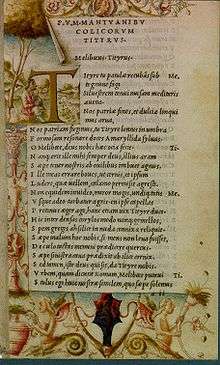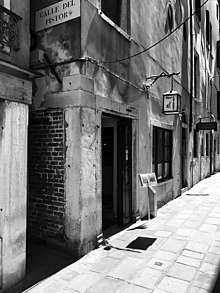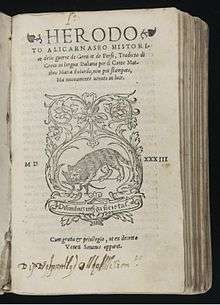Aldine Press
The Aldine Press was the printing office started by Aldus Manutius in 1494 in Venice, from which were issued the celebrated Aldine editions of the classics (Latin and Greek masterpieces plus a few more modern works). The first book that was dated and printed under his name appeared in 1495.[1]


The Aldine Press is famous in the history of typography, among other things, for the introduction of italics.[2] The press was the first to issue printed books in the small octavo size, similar to that of a modern paperback, and like that intended for portability and ease of reading.[1]:82-84 According to Curt F. Bühler, the press issued 132 books during twenty years of activity under Aldus.[1] After Aldus’s death in 1515 the press was continued by his wife, Maria and her father, Andrea Torresani (Andrea Torresano), until his son, Paulus Manutius (1512–1574) took over. His grandson Aldus Manutius the Younger then ran the firm until his death in 1597. Today, the antique books printed by the Aldine Press in Venice are referred to as Aldines.[3]
The press enjoyed a monopoly of works printed in Greek in the Republic of Venice, effectively giving it copyright protection. Protection outside the Republic was more problematic, however. The firm maintained an agency in Paris, but its commercial success was affected by many counterfeit editions, produced in Lyons and elsewhere.[4]
Beginnings

Aldus Manutius, the founder of the Aldine Press, was originally a humanist scholar and teacher. Manutius met Andrea Torresani, who had acquired publishing equipment from Nicholas Jensen's widow. The Aldine Press was originally owned half by Pier Francesco Barbarigo, the nephew of the current doge of the time, Agostino Barbarigo, and the other half by Andrea Torresani. Manutius owned one fifth of Torresani's share. Manutius mainly was in charge of the scholarship and editing, leaving financial and operating concerns to Barbarigo and Torresani. In 1496, Aldus established his own location in a building called the Thermae in the Sestiere di San Polo on the campo Sant'Agostin[5][6] today civico numero 2343 San Polo on the calle della Chiesa, now the location of the restaurant Due Colonne.[5][6] Though there are two commemorative plaques on the building civico numero 2311 Rio Terà Secondo, historians regard them to be erroneously placed based on contemporaneous letters addressed to Manutius;[7][8][9][10][11][12][13][14][15][16][5][6] the first erroneous plaque had been placed by Abbot don Vincenzo Zenier in 1828.[17][7][8][9][5][6] Manutius lived and worked in the Thermae to produce published books from the Aldine Press. This was also the location of the "New Academy", where a group of Manutius' friends, associates, and editors came together to translate Greek and Latin texts.[18]:1-5 In 1505, Manutius married Maria, the daughter of Andrea Torresani of Asola.[19] Torresani and Manutius were already business partners, but the marriage combined the two partners' shares in the publishing business.[20] After the marriage, Manutius lived at Torresani's house.[20] Shrinking in popularity, in 1506 the Aldine Press was moved to Torresani's house in the parish of San Paternian. It was demolished in 1873 and now covered by a bank building in the Venice square, Campo Manin.[20]
Accomplishments of the Aldine Press
The press was started by Manutius based on his love of classics and the need of preservation of Hellenic studies. At first the press printed new copies of Plato, Aristotle, and other Greek and Latin classics. Manutius also printed dictionaries and grammars to help people interpret the books, used by scholars wanting to learn Greek to employ learned Greeks to teach them directly.[21] Historian Elizabeth Eisenstein claimed that the fall of Constantinople in 1453 had threatened the importance and survival of Greek scholarship, but publications such as those by the Aldine Press secured it. Erasmus was one of the scholars learned in Greek with whom the Aldine Press partnered in order to provide accurately translated text.[21]:221 The Aldine Press also expanded into current languages, mainly Italian and French.[18]

Humanist typefaces
Aldus Manutius hired Francesco Griffo to create a typeface designed to reproduce the written hand of the humanists. This resulted in the first roman face adapted and known today as italic type. It was first used to print Cardinal Pietro Bembo's De Aetna in 1495. Before this time print publishing used block letters, the look of handwriting as print was a new phenomenon and, try as he might to prevent it, Manutius' typeface was illegally copied, spreading through Europe.[2]
Aldus Manutius the Elder's portable books
In 1505 Manutius produced plain texts in useful form, using the term enchiridion, meaning a manual or small, hand-held weapon.[18] The octavo was the first appearance of the editio minor, a straightforward text, established as well as the editor can manage. Although these new, portable books were not cheap, the books of the Aldine Press did not force upon their buyers a substantial investment that large volumes of text and commentary demanded during this era. The editio minor, instead, brought financial and logistical benefits to those interested in the classics. An individual didn't have to go to the book, rather now the book came along with them.[18]:1-7
Imprint and motto
In 1501, Aldus used as his publisher's device the image of a dolphin wrapped around an anchor.[22] "The dolphin and anchor device owed its origins most immediately to Pietro Bembo. Aldus was to tell Erasmus six years later that Bembo had given him a silver coin minted under the Emperor Vesparian and bearing an image of this device"[23] The image of the dolphin and anchor on the coin came with a saying, "Festina Lente", meaning "make haste slowly". This would become the motto for the Aldine Press.[18]
The Aldine Press after 1515
Aldus Manutius the Elder died on February 6, 1515. After his death the firm was run by Andrea Torresani and his daughter, Maria, the widow of Aldus Manutius. The Aldine Press was named in 1508 as "In the House of Aldus and Andrea Torresano" which kept this name until 1529. In 1533, Paulus Manutius managed the firm, starting it up again and changing its name to "Heirs of Aldus and Andrea Torresano". In 1539 the imprint changed to "Sons of Aldo Manuzio". In 1567 Aldus Manutius the Younger continued the business until his death.[4]
Publications
A partial list of publications from the Aldine Press cited from Aldus Manutius: A Legacy More Lasting than Bronze.[24]
- Musarum Panagyris Aldus Manutius, after March 1487 and before March 1491.
- Erotemata cum interpretatione Latina Constantine Lascaris, 8 March 1495.
- Opusculum de Herone et Leandro, quod et in Latinam Linguam ad verbum tralatum est Musaeus, before November 1495 (Greek text) and 1497/98 (Latin text).
- Dictionarium Graecum Johannes Crastonus, December 1497.
- Institutiones Graecae grammatices Urban Valeriani, January 1497.
- Rudimenta grammatices latinae linguae Aldus Manutius, June 1501.
- Poetae Christiani veteres, June 1502.
- Institutionum grammaticarum libri quatuor Aldus Manutius, December 1514.
- Suda, February 1514.
Works published from the Greeks. Manutius printed thirty editiones principes of Greek texts, allowing these texts to escape the fragility of the manuscript tradition.
- Eclogae triginta... Theocritus, February 1496.
- Theophrastus de historia plantarum... Aristotle, 1 June 1497.
- De mysteriis Aegyptiorum, Chaldaeorum, Assyriorum... Iamblichus, September 1497.
- Aristophanis Comoediae novem Aristophanes, 15 July 1498.
- Omnia opera Angeli Politiani... Angeloa Ambrogini Poliziano, July 1498.
- Herodoti libri novem quibus musarum indita sunt nomina Herodotus, September 1502.
- Omnia Platonis opera Plato, May 1513.
- Oratores Graeci, May 1513.
- Deipnosophistae Athenaeus, August 1514.
Latin works
- Scriptores astronomici veteres Firmicus Maternus, 17 October 1499.
- Petri Bembi de Aetna ad Angelum Chabrielem liber Pietro Bembo, February 1496.
- Diaria de Bello Carolino Alessandro Benedetti, 1496 (the first published work of the Aldine Press using the humanist typeface).
- Libellus de epidemia, quam vulgo morgum Gallicum vocant Niccolò Leoniceno, June 1497.
- Hypnerotomachia Poliphili Francesco Colonna, December 1499.
- Epistole devotissime de Sancta Catharina da Siena St. Catherina of Siena, 19 September 1500.
- Opera Publius Vergilius Maro, April 1501.
- Opera Quintus Horatius Flaccus, May 1501.
- Rhetoricorum ad C. Herennium...libri Marcus Tullius Cicero, March 1514.
Libelli Portatiles
- Le cose volgari de Messer Francesco Petrarcha Francesco Petrarca, July 1501.
- Opera Catullus, Tibullus, and Propertius, January 1502.
- Epistolae ad familiares Marcus Tullius Cicero, April 1502.
- Le terze rime Dante Alighieri, August 1502.
- Pharsalia Marcus Annaeus Lucanus, April 1502.
- Tragaediae septem cum commentariis Sophocles, August 1502.
- Tragoediae septendecim Euripides, February 1503.
- Fastorum...libri, de tristibus..., de ponto Publius Ovidius Naso, February 1503.
- Florilegium diversorum epigrammatum in septem libros Greek Anthology, November 1503.
- Opera Homer, after 31 October 1504.
- Urania sive de stellis Joannes Jovianus Pontanus, May & August 1505.
- Vita, et Fabellae Aesopi... Aesop, October 1505.
- Epistolarum libri decem Gaius Plinius Caecilius Secundus, November 1508.
- Commentariorum de Bello Gallico libri Gaius Julius Caesar, December 1513.
- Odes Pindar, January 1513.
- Sonetti et Canzoni. Triumphi Francesco Petrarca, August 1514.
Archives
The most nearly complete collection of Aldine editions ever brought together was in the Althorp library of the 2nd Earl Spencer, now in the John Rylands Library, Manchester.[25]
In North America, the most substantial Aldine holdings can be found in the Ahmanson-Murphy Aldine Collection at University of California, Los Angeles,[26] at the Harry Ransom Center at University of Texas at Austin,[27] and at the Harold B. Lee Library at Brigham Young University.[28]
References
- Barolini, Helen (1992). Aldus and His Dream Book. New York, New York: Italica Press, Inc. ISBN 0-934977-22-4.
- Seddon, Tony (2015). The Evolution of Type. Canada: Firefly Books Ltd. 2015. ISBN 978-1-77085-504-5.
- Bühler, Curt F. (1950). "Aldus Manutius: The First Five Hundred Years". The Papers of the Bibliographical Society of America. 44 (3): 205–215. doi:10.1086/pbsa.44.3.24298605.
- Goldsmid, Edmund (1887). A Bibliographical Sketch of the Aldine Press at Venice: 3 Volumes. Edinburgh: Privately Published.
- Knoops, Johannes (2018). In Search of Aldus Manutius a campo Sant'Agostin. Venice, Italy: Damocle. pp. 17–23. ISBN 978-88-943223-2-3.
- Knoops, Johannes. "In Search of Aldus Manutius a campo Sant'Agostin". ISSUU. Retrieved February 10, 2020.
- Cigogna, Emmanuele Antonio (1830). Delle inscrizioni veneziane raccolte ed illustrate. Venezia: presso G. Picotti. pp. 41–42. ISBN 978-0428501563.
- Tassini, Giuseppe (1863). Curiosita Veneziane Ovvero Origini Delle Denominazioni Stradali di Venezia, vol. 1. Venezia: Primiata Tipografia di Gio. Cecchini. pp. 12–13. ISBN 978-1241740559.
- Tassini, dottor Giuseppe (1887). Curiosità veneziane, ovvero origini delle denominazioni stradali di Venezia, fourth edition. Venezia: F. Ongania. p. 10. ISBN 978-1241740559.
- Castellani, Carlo (1889). La stampa in Venezia dalla sua origine alla morte di Aldo Manuzio senior. Venezia: F. Ongania. pp. 55–57. ISBN 978-1274832429.
- Brown, Horatio F. (1891). The Venetian Printing Press: an historical study based upon documents for the most part hitherto unpublished. London & New York: New York, G. P. Putnam's sons; London, J. C. Nimmo. pp. 43.
- Pastorello, Ester (1965). Di Aldo Pio Manuzio: Testimonianze e Documenti. Firenze: Olschki.
- Norwich, Sir John Julius (1982). A History of Venice. London: Knopf. p. 412. ISBN 9780679721970.
- Fletcher III, H. George (1988). New Aldine Studies, 1988. San Francisco: B.M. Rosenthal. pp. 62–63. ISBN 9780960009411.
- Bassi, Elena (1993). La chiesa di Sant'Agostino di Venezia, in Atti dell'Istituto Veneto di Scienze, Lettere ed Arti. Classe di scienze morali, lettere ed arti. Venice: Istituto Veneto di Scienze, Lettere ed Arti. pp. 297–299.
- Fletcher III, H. George (1995). In Praise of Aldus Manutius. New York: Pierpont Morgan Library. ISBN 978-0295974651.
- "OPAC Ecografico-Toponomastica". www.albumdivenezia.it. Retrieved 2020-02-17.
- Fletcher III, Harry George (1988). New Aldine Studies. San Francisco: Bernard M. Rosenthal, Inc. ISBN 0-9600094-1-8.
- Barolini, Helen (1992). Aldus and His Dream Book, , New York, 1992. New York: Italica Press. p. 84. ISBN 9780934977227.
- Fletcher III, H. George (1988). New Aldine studies: documentary essays on the life and work of Aldus Manutius. San Francisco, CA: B.M. Rosenthal, Inc. pp. 1–8. ISBN 978-0960009411.
- Eisenstein, Elizabeth L. (1979). The Printing Press as an Agent of Change. Cambridge, England: Cambridge University Press.
- H. George Fletcher, In praise of Aldus Manutius (New York: Morgan Library, 1995), pp. 26–27.
- Mortimer, Ruth (1974). Catalogue of books and Manuscripts. Part II. Italian 16th Century Books. 2 vols. Cambridge: Belknap Press of Harvard University Press.
- George Fletcher, Scott Clemons (2015). Aldus Manutius: A Legacy More Lasting than Bronze. New York: The Grolier Glub.
- A Guide to Special Collections (1999)
- "Aldine Press". UCLA Library. Retrieved 25 July 2017.
- "Aldine Press". Harry Ransom Center: The University of Texas at Austin. Archived from the original on 27 February 2013. Retrieved 25 July 2017.
- "Aldine Checklist". Exhibits of BYU Library. Retrieved 25 July 2017.
Bibliography
- Barolini, Helen. Aldus and His Dream Book: An Illustrated Essay. New York: Italica Press, 1992.
- Braida, L. (2003) Stampa e cultura in Europa. Roma-Bari: Laterza
- Davies, Martin (1995) Aldus Manutius: printer and publisher of Renaissance Venice. London: British Library
- Febvre, L. & Martin, H. (2001) La nascita del libro. Roma-Bari: Laterza
- Fletcher, H. G., III (1988) New Aldine Studies: documentary essays on the life and work of Aldus Manutius. San Francisco
- Lowry, Martin (1984) Il mondo di Aldo Manuzio – Affari e cultura della Venezia del Rinascimento. Roma: Il Veltro, pp. 441 (Translated from: The World of Aldus Manutius: Business and Scholarship in Renaissance Venice, Basil Blackwell, Oxford, 1979). II edizione, con aggiornamento bibliografico, Roma 2000.
- Madden, Thomas F (2012). Venice : A New History (Hardback). New York: Viking. ISBN 978-0-670-02542-8.
- Renouard, A. A. (1834) Annales de l'imprimerie des Aldes, ou l'histoire des trois Manuce et de leurs éditions; 3ème édition. Paris (the standard bibliography)
- Soave, Fiammetta (1991) Bibliotheca Aldina: a collection of one hundred publications of Aldus Pius Manutius and the Aldine Press, including some valuable Aldine conterfeits [sic]. Rome: F. Soave